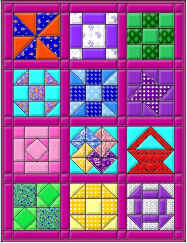Name: DeDe Tersteeg
School District: Blue Ridge
Lesson Title: Quilt Design
Grade Level: 8th
Piloted with students in grade: 8th
PA STANDARD AREA: ARTS AND HUMANITIES
|
x |
9..1 Producing, Performing and Exhibiting |
 |
|
|
9..2 Historical and Cultural Contexts |
|
|
|
9..3 Critical Response |
|
|
9..4 Communicate Aesthetic Response |
Specific Standard: (8) Interpret Ideas that Generate works in the arts.
9.1 (B) Recognize, know, use and demonstrate a variety of appropriate arts elements and principles to produce, review and revise original works in the arts.
9.1 (J) Apply traditional and contemporary technologies for producing, performing and exhibiting work in the arts or the works of others
9.2 (A) Explain the historical, cultural and social context of an individual work in the art
Lesson Topic/theme Create a symmetrical two dimensional quilt design
overview: Three 40min class lessons to design a quilt
Keywords: Quilt (History, Styles), template, grid, symmetry, pattern, center-emphasis, quilt design
Learning Objective(s): (What will all students do to demonstrate they have reached the standard?)
Identify and classify the elements and principles of design through the exploration of quilts.
Observe, define and analyze historical varieties of quilts mathematically and aesthetically.
Recognize and implement the fundamental principles of design used to create traditional quilt patterns.
Successfully integrate the elements and principles of design into their symmetrical quilt design.
Understand the relationship of composition/spatial structure to unify the work.
Create a center-emphasis quilt design.
Evaluate the strengths and weaknesses of their design to discriminate between degrees of quality in his/her own design.
Materials: (type in 8 lines or less) Historical Quilt Prints and Elements and Principles of Design (taken from :Quilt History, Quilt Patterns, Elements and Principles of Design), student models (from earlier sessions), quilt templates, 10x10 white drawing paper, pencils, rulers, black markers.
Warm-Up:
A. Review student models from earlier extensions.
B. Reinforce: (1) function of line to create shape, (2) how line defines pattern.
C. Model with student a variety of small scale (four and eight squares) pattern options.
D. Model with students a variety of directional grid designs (horizontal, vertical and diagonal).
Procedure:
Students are to be given a 10x10 piece of white drawing paper to create one inch grid template surface.
Students are then asked to identify twelve center squares to create a center emphasis smaller scale design.
Utilizing the remainder of the grid's peripheral pattern, students are to design a black and white quilt, identifying clusters of the grid they created earlier, that radiates from the center focus guilt design.
Students are to emphasize using shape, line and pattern to balance the contrast of black (marker) and white (paper) in their quilt design.
Correctives: (Enrichment activities for students who have not met the standard at proficient or advanced level) Students are to implement using a larger scale grid in order to simplify the mathematical breakdown of the pattern design.
Extensions: (Additional activities for students who have met the standard at a proficient or advanced level) Students can move from black and white to color or hue variations, allowing them to create the effect of three-dimensional patterns.
Assessment-Task Criteria: How will you judge below basic, basic, proficient and advanced? Do you have a model/exemplar of your expectations?
Below Basic Student demonstrates limited competence in creating
a symmetrical quilt design on a grid surface. Student was unable to define sets of
squares to create a balance to their quilt
design. Student was unable to define a center
emphasis by reducing the center grid. Presentation detracts from the
quality of the quilt design. Basic Student demonstrates partial
competence in creating a symmetrical quilt
design on a grid surface. Materials and elements are used with
limited success. Presentation of the work contributes
little to the effectiveness of the quilt
design. Proficient Student demonstrates competence in all criteria
of creating a symmetrical quilt design on a grid
surface. Student implemented a symmetry to their design
that radiated in balance from the center
emphasis design. Materials and elements are well used. Presentation of the work contributes to the
effectiveness of the quilt design Advanced Student demonstrates an advance
level of competence in creating a symmetrical quilt
design on a grid surface. Materials and design elements are used very
effectively. Presentation of the work strongly enhances the
the effectiveness of the work.